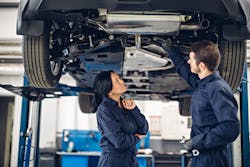I want to start this month with a confession. I have a definite agenda for this article, which I believe will become evident as you read it.
If I were to ask you what you opened your shop to do, what would your answer be? I know you’re probably thinking, “What are you sniffing, Rick? I opened my shop to fix cars!” And this, my friend, is where the problem in our industry starts. Let’s dive into the focus every business needs to have to be successful.
Management guru Peter Drucker said, “The purpose of any business is to create and keep a customer.” This is true whether you’re a plumber, a chiropractor, a doctor, a butcher, or a candlestick maker. Let’s face it: this makes sense because a business with no customers is just a hobby!
Economist Milton Friedman argued that the goal of any business is to generate a profit. Profit is NOT a dirty word. I’ve heard profit defined as the applause your customers give you for a job well done. Profits allow for equipment purchases, hiring top talent, retaining the talent you have, giving back to the community, and a lifestyle of your choosing for you and your family.
Profit is the difference between owning a business or creating a super hard job. As a coach, nothing is sadder to me than seeing business owners working their butts off 70 to 90 hours a week with no profit to show for their effort. They end up being compensated for an amount they would never accept working somewhere else. Many shop owners get fixated on growth, but a sale without profit is simply more work. The antidote to just working is to have a profit model and base all your decisions on how they’ll affect your profit.
The key to business success comprises two ingredients: raving fans and profit. I hope you’ve noticed that not once have I mentioned fixing cars. That’s because fixing cars is the “vehicle” (pun intended) you’ve chosen to create and keep a customer while generating a profit!
Increasing profitability doesn’t mean fixing more cars
But because you’ve focused on fixing cars, you mistakenly believe that all you need to be more profitable is to fix more cars. And nothing could be further from the truth. Adding more cars to your day creates an environment entirely focused on activity.
When you’re activity based:
You have a lower average repair order because as you add more cars to your schedule, your team has less time to work on each one.
You will experience lower profits because lower average tickets mean less profit per invoice.
You will have a bottleneck at the front counter because your advisors can’t keep up with the number of vehicles.
You will have ambivalent customers due to a transactional focus because your team can’t invest the time with each person building and cultivating a relationship that matters.
You will have unhappy customers because you make promises you can’t keep caused by the chaos of activity and inevitable snags and delays.
Your team will be wound tighter than a guitar string due to the workload and expectations you have for them.
And as profits shrink, you frantically grasp for more and more cars. This cycle continues in a downward spiral, with you getting more frustrated and bitter as time goes on.
Before you lock your doors for keeps, I want to show you a solution to your increasing frustration and decreasing bank balance. That solution is to SLOW DOWN. That’s right, I said it. SLOW DOWN. The secret is to do more with less. Let me show you.
When you slow down, you can invest more time with your client getting to know them, their buying motive, their current concerns, how they’re using the vehicle today, and what their plans are for their vehicle. You can focus on showing care, concern, creativity, confidence, and certainty. You can identify their problem and position yourself as their solution. In other words, you can create a client instead of having a customer. What do I mean by a client instead of a customer? I’m glad you asked.
Climbing the ‘Loyalty Ladder’
I want to introduce you to “The Loyalty Ladder.” On the lowest step, you have a citizen. A citizen is someone who doesn’t know you exist. A candidate is the next step in climbing the Loyalty Ladder. A candidate is someone who knows who you are but hasn’t done business with you (yet). Continuing up the ladder, the next step is a consumer. A consumer is someone who’s done business with you once. Consider them a guest, and they’re trying you on for size. If they like their visit and come back, they’ve just climbed to the next rung and become a customer. A customer is someone who has decided to come back again. As you get more comfortable with each other, they ascend the ladder to their next perch to become a client. A client is someone you have a deeper understanding of their needs, wants, and goals, and they see you as a trusted advisor. And finally, with much intention, your client climbs to the top of the Loyalty Ladder and becomes a champion. A champion loves what you do for them and does everything they can to help you succeed, including recommending others.
For me, this is what it means to create and keep a customer. It means actively creating champions. And the ingredient that fuels their climb up the Loyalty Ladder is trust. I could go deeper here, but that’s another article.
Shift perspectives from ‘fix a broken car’ to ‘helping keep them on the road.’
Slowing down also allows you and your team to shift from a “fix a broken car” perspective to a “helping them keep it on the road” perspective. Instead of just fixing their vehicle and getting them back on the road, focus on partnering with your client and keeping their vehicle on the road safe, reliable, and as efficient as possible. This means concentrating on the complete vehicle, finding issues before they cause a breakdown or a need for a surprise visit outside of their scheduled visits, and helping your client maximize the investment in their vehicle by recommending maintenance services. This focus enables you to maximize the opportunity you already have in your bays without adding more cars.
A key indicator of how well you’re doing at this shift in perspective is called Sold or Billed Hours per Repair Order. A typical repair shop with no management training will average 1.3 to 1.7 hours of sold or billed labor per repair order. A general repair shop with training will average 3.0 to 3.5 sold or billed hours per repair order. A European repair shop with training will average 4.0 to 5.0 sold or billed hours per repair order. When you think about the age of the vehicle that you’re working on and an average of two visits per year, these targets are completely attainable in a moral, ethical, and legal way.
If you are a shop owner frustrated at how much you’re working and how little you’re achieving, I hope now you can see that by slowing down, you can create a better environment for your team and the people you serve. If you’d like a calculator showing you where you are now and where you could be by managing your Sold or Billed Hours/RO metric, go to www.180biz.com/profit and download an Excel spreadsheet to help you dream and grow.
About the Author
Rick White
Rick White is a business-turnaround and exponential growth expert who helps auto repair shop owners go from struggling to stay open to being recognized as the go-to shops in their market. He helps business owners with average shops transform their shop into the shop of the year in the industry.
Currently, Rick is President of 180BIZ, an auto repair shop training and business coaching company proudly serving the independent auto and truck repair shop owner since 2006. He has also owned multiple successful auto repair shops over the years.
Rick has taught at some of the biggest conferences in the industry across North America, including classes at AAPEX (Nevada), VISION (Kansas), ASTE (North Carolina), ATSE (New York), ASA National, and AASP National. Beyond Associations, he has conducted training classes for WorldPac and BG. He has been published many times over the years for multiple automotive repair industry publications. Contact him at [email protected] or visit his website at www.180biz.com.

